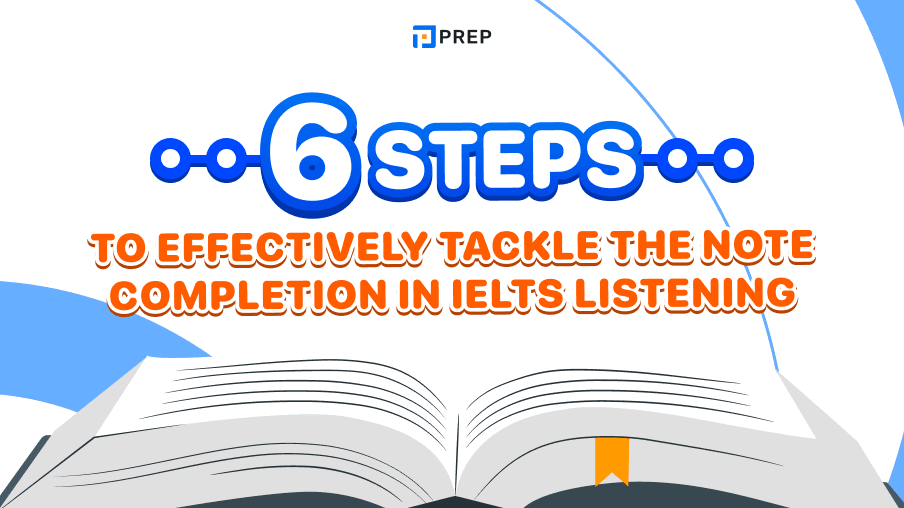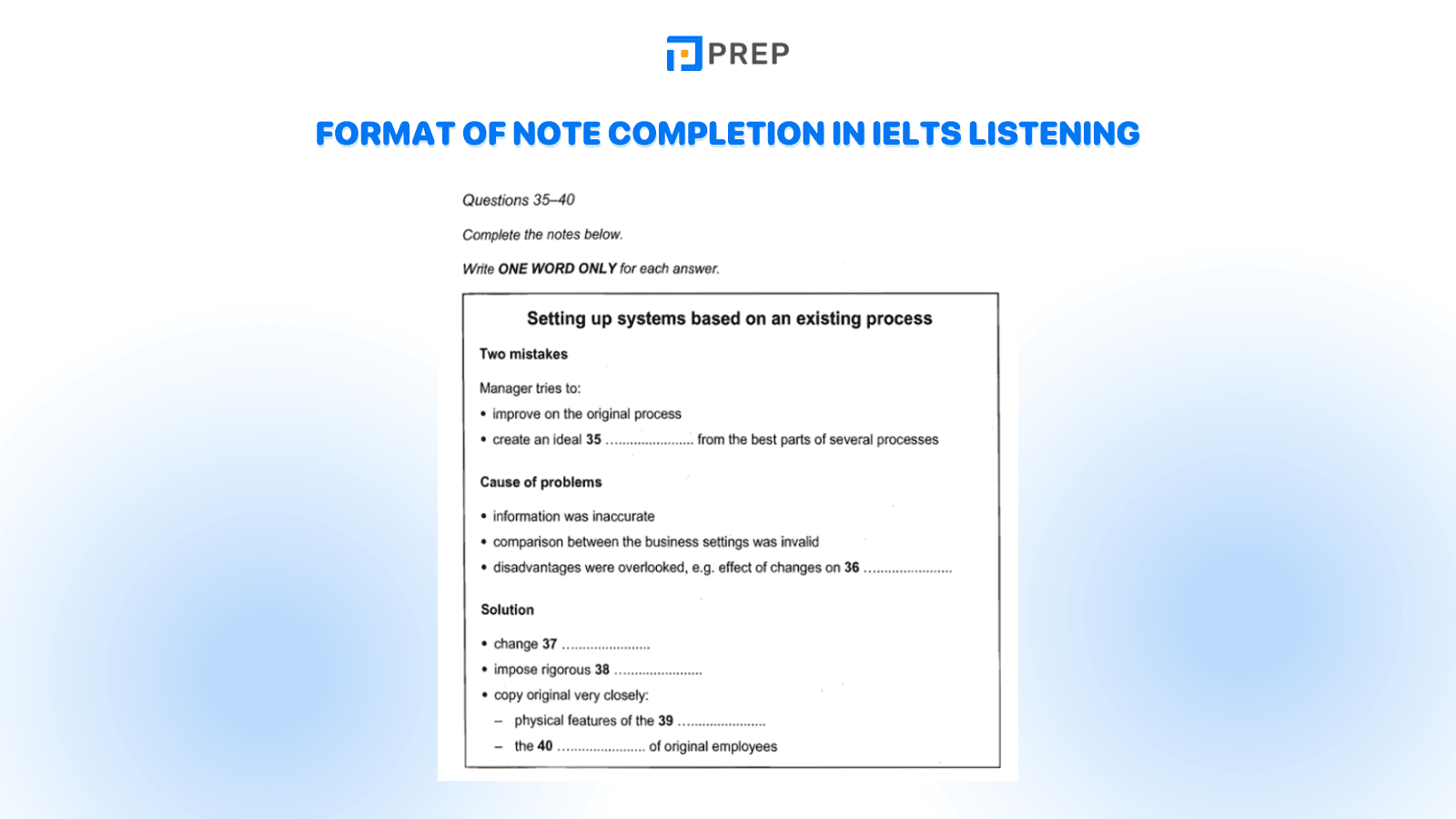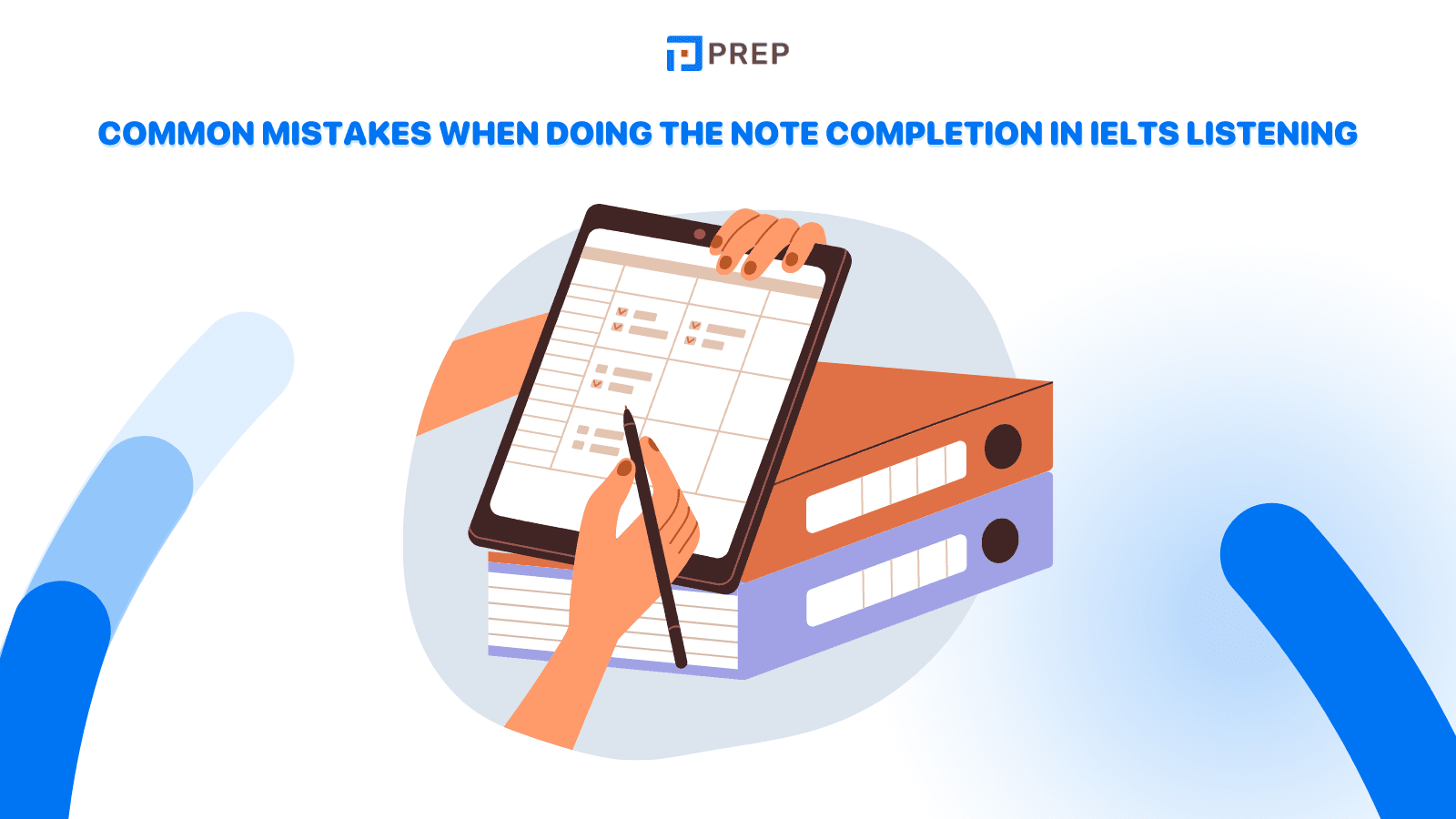Search blog
6 steps to effectively tackle the Note Completion in IELTS Listening
In the ongoing series of articles discussing "IELTS Listening question types and strategies," PREP focuses on the Note Completion in IELTS Listening. Therefore, let's delve into the following details promptly to effectively address this question type in this article.

- I. What is the Note Completion in IELTS Listening?
- II. Format of Note Completion in IELTS Listening
- III. Common mistakes when doing the Note Completion in IELTS Listening
- IV. Steps to conquer the Note Completion in IELTS Listening
- V. Useful tips for handling the Note Completion in IELTS Listening
- VI. Exercises on Note Completion in IELTS Listening with detailed answers
I. What is the Note Completion in IELTS Listening?
Note Completion in IELTS Listening is a question type that requires candidates to fill in the blanks to complete a given summary. This is also one of the most frequently appearing question types in almost every IELTS Listening test. Note Completion questions mainly appear in Part 2 and Part 4 of the listening test. Here's an example of a Note Completion question in IELTS Listening:

II. Format of Note Completion in IELTS Listening
How can you recognize the Note Completion question type in the IELTS Listening test? You can identify it through the following characteristics:
- Note Completion questions often appear at the end of the listening section with 10 questions. Usually, candidates will listen to a lecture by a professor on an academic topic. Similar to being in a lecture hall, students are required to take notes during the lecture. This question type tests the ability to recognize specific information to fill in the gaps. The questions will indicate how many words or letters are needed for each blank.
- Spelling is crucial, so try not to lose points due to spelling mistakes.
- You will only hear the recording once, so it's important to stay focused while listening.
- Most importantly, for a lecture by a professor on an academic topic, if you don't have the necessary vocabulary, you won't be able to understand even with all the tips and tricks. Therefore, continuously expose yourself to various topics to improve your language skills.

III. Common mistakes when doing the Note Completion in IELTS Listening
Many candidates lose points when taking the IELTS Listening test, especially with the Completion question type. Take a look at and avoid these common mistakes so that you can perform well in the Listening test and achieve a high band score.
- Carelessness and lack of attentiveness: Many mistakes occur due to lack of attention, resulting in spelling errors. Just one wrong word can make the entire word incorrect, for example, "lighting" and "lightning" are different by just one letter.
- Superficial checking of answers: It's important to check the answers against your predictions to correct any grammar mistakes.
- Lack of vocabulary: Some words may need to be guessed, such as "bush honey," which can be inferred based on pronunciation. It cannot be written as "push honey."
- Trapped by misleading information: This is one of the most fundamental mistakes. Therefore, read the question carefully and listen attentively to the audio to avoid falling into traps of misleading information.

IV. Steps to conquer the Note Completion in IELTS Listening

To achieve a high score in the Note Completion question type in the IELTS Listening test, you need to know how to approach it quickly and effectively. Master the following steps and apply them in real IELTS Listening exams to achieve your target band score, Preppies!
- Step 1: Read the task requirements: Read the requirements in the task to know the word and number limits for the answers.
- Step 2: Read the heading: Read the heading to understand the topic of the note. This step helps to recall vocabulary related to the topic.
- Step 3: Read the question + underline keywords: Underline keywords to pay attention to where the recording is discussing and to be more alert to the information.
- Step 4: Predict: Predict the information to be filled in + predict traps/be cautious about certain information. Usually, you will hear paraphrases of keywords, and this step requires continuous practice to be able to recognize paraphrases. Traps often involve singular/plural nouns and traps when hearing numbers ending in -teen and -ty. It's normal to make mistakes if you don't anticipate the traps.
- Step 5: Listen + fill in the answers: Listen to the audio and fill in the answers on the answer sheet.
- Step 6: Check the answers: Candidates often skip this step, which is regrettable as it can lead to avoidable errors. Sometimes, just spending 30 seconds to review can increase the number of correct answers. Remember to compare your predictions with the answers to see if they match.
V. Useful tips for handling the Note Completion in IELTS Listening

To improve listening skills, the first thing we need to do is expand our vocabulary. In addition, we should never underestimate the importance of making predictions before listening, as this is the key to actively listening and staying focused. Predictions help us become more sensitive in making informed decisions rather than random guesses. Lastly, we need to maintain a high level of concentration and avoid distractions. Sometimes, we need to infer the answers based on context, pronunciation, and grammar for words we are unfamiliar with.
VI. Exercises on Note Completion in IELTS Listening with detailed answers
1. Note Completion Listening practice - Exercise 1
Listening file: Here
Answer keys:
- 1. central
- 2. 600
- 3. two years
2. Note Completion Listening practice - Exercise 2
Listening file: Here
Answer keys:
- MILPERRA
- first class movers
- 28 November
- screen
- bathroom
- door
- 140
- leg
- plates
- 60
With the 6-step guide for handling the Note Completion in IELTS Listening as mentioned above, PREP hopes that you can refer to the article in detail to prepare well for the upcoming IELTS test. However, the 6 steps may vary for some candidates. Therefore, try experimenting during your self-study of IELTS at home and then choose the most suitable method for yourself to achieve the desired score.

Comment
Search blog
Đăng ký tư vấn lộ trình học
Bạn hãy để lại thông tin, Prep sẽ liên hệ tư vấn cho mình ngay nha!
